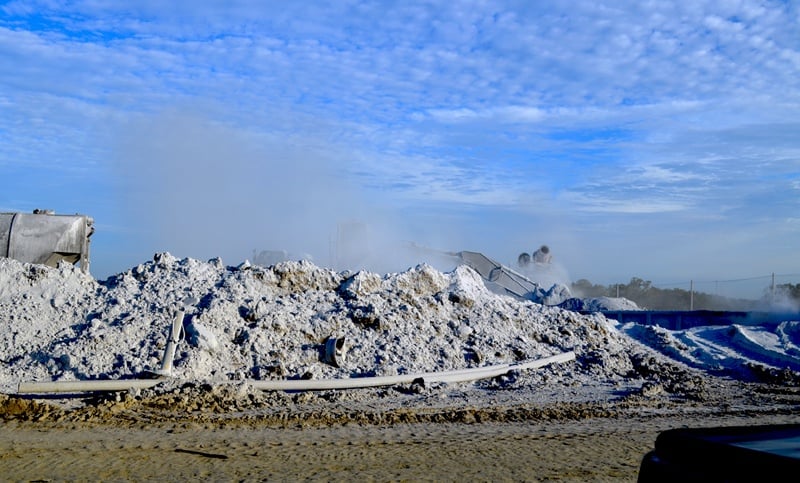If you work in an industry that uses powdered materials, such as construction or stonecutting, you know that airborne dust can be a real problem. Not only is it a nuisance, but it can also be dangerous to people’s health.
Inhaling too much dust can cause eye and skin irritation, which may disrupt your ability to work. Even worse, it can lead to more serious respiratory problems – like asthma and sometimes lung cancer.
So, how do you prevent these risks to human health? That's what we're talking about in this article. We'll look at some of the ways tarps can be used to control dust and safely dispose of airborne waste.
What Industries Use Tarps for Dust Control and Airborne Waste Disposal?
There are a number of industries that use tarps for dust control and airborne waste disposal. These industries include:
-
Demolition Sites
Demolition sites use tarps for dust abatement to contain the debris created when buildings are demolished. The tarps are placed over the work area to capture the dust and other contaminants before they have the chance to disperse into the air. This helps sites meet environmental regulations and protect the health of workers and nearby residents.
-
Construction Companies
Construction sites also use tarps for dust control. In particular, they are used to cover materials that produce dust, such as concrete and asphalt.
This is important because construction dust is made up of a variety of dangerous materials, including asbestos, lead, and other harmful toxins. By using tarps to control the dust, you can protect workers and passersby from exposure to these pollutants.
-
Stonecutting or Masonry
The debris created by stonecutting and masonry work is very fine and can quickly become airborne. This dust can be dangerous to breathe, so it's important to control and contain it. Tarps are often used in this industry to capture the dust before it disperses.
-
Dirt and Sand Haulers
Hauling dirt and sand can stir up a lot of dust, which can be harmful to both the driver and anyone who happens to be nearby. To protect both, many haulers will cover their loads with specialized tarps designed for safe airborne waste disposal.
-
Landfills
The Environmental Protection Agency (EPA) regulates landfills to control the release of methane gas and other pollutants. One way they do this is by requiring that the landfill be covered with a tarp when it's not in use. This helps to prevent contaminants from escaping into the atmosphere.
-
Sandblasting
Sandblasting uses high-pressure air to blast sand at a surface. This can be used to remove paint or rust from metal, clean stone, or etch glass. The process can create a lot of dust, which may harm the workers and the environment. To control this dust, sandblasters will often use tarps to cover the work area.
How Do Tarps Work for Dust Control and Airborne Waste Disposal?
Tarps work for dust control and airborne waste disposal by creating a physical barrier between the dust and the air. The tarps trap the dust before it has a chance to disperse into the atmosphere.
There are many different equipment tarps available - each designed for different applications.
For example, fitted tarps are often used in transport for airborne waste disposal. Layflat tarps, on the other hand, are used for landfill covers and similar applications. There are many sizes, shapes, and materials available, so it's essential to choose the right one for your needs.
What Materials are Used in Tarps for Dust Control and Airborne Waste Disposal?
The most commonly used materials in tarps for dust abatement and airborne waste disposal are vinyl and mesh.
Vinyl is a heavy-duty, lightweight material that is strong enough to withstand high winds and debris. It's also waterproof, so it can help to prevent the dust from becoming wet and difficult to control. Vinyl tarps are great for cargo transport and other applications.
Mesh tarps are also popular because they allow air to flow through them while still trapping the dust on the other side. This combination of strength and breathability makes mesh tarps a good choice for many applications. For instance, they can be used to cover openings in paper compactors to allow air to circulate while still trapping the dust inside.
How Do You Determine the Best Tarp for Your Needs?
When looking for a tarp to use for dust control and airborne waste disposal, consider the following factors:
-
Size
The size of the tarp you need will depend on the area you need to cover. For example, if you are using the tarp to cover a cargo container, a somewhat smaller tarp will be sufficient. However, if you need to cover a large area, such as a landfill, you will need a larger tarp.
-
Material
The material of the tarp is also important to consider. As mentioned above, vinyl and mesh are two of the most common materials used in tarps for dust abatement and airborne waste disposal. Each material has its own advantages and disadvantages that you should consider before making a decision.
-
Application
Lastly, think about the tarp’s application. How will you be using it?
This will help you to choose the right size, material, and other features for the tarp. For example, if you will be using the tarp to cover a landfill, you will need a large, lay flat tarp. If you are using the tarp to protect a sandblasting site, you may need a smaller, more fitted tarp.
Conclusion
Overall, tarps are a great way to control dust and airborne waste disposal. They are low-cost and come in various sizes, shapes, and materials to suit a variety of needs.
Looking to use a tarp for dust control and/or airborne waste disposal? Get a free, no-obligation quote from today!




